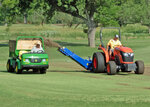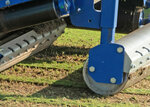

After exhausting traditional methods to combat the annual bluegrass weed, Squaw Valley Golf Course in Glen Rose has turned to the process of fraise mowing to prolong the life of the course's greens, which will require the closing of its Comanche Lakes course for a couple of weeks.
Poa annua, or annual bluegrass, is unavoidable in parts of Texas and, like most weeds, survives in tight, compacted soils. The weed flowers throughout the day and creates nightmares for golfers because it makes the green's putting surface bumpy.
According to Squaw Creek superintendent Trevor Ogden, he and his team have exhausted the traditional methods for controlling and eliminating the pesky weed. They have worked with herbicide companies and universities but have not achieved the desired results.
Facing complaints from golfers and the realization the greens' life expectancy was being shortened, Squaw Valley general manager Jeff Hanson recommended a solution that was long-term but also a new and unique method to get the bluegrass under control on golf courses.
Squaw Valley has done its research, and a year ago, the two course officials oversaw the fraise mowing of a practice green, and the test results were so good the pair are moving forward with all 18 greens on the Comanche Lakes Course.
"The process results in the removal of thatch, leaf tissue, and seed bead with hopes of removing some organic matter and ultimately removing bluegrass seed bed from the soil," Ogden said.
Ogden compared fraise mowing to a wood planer or grinder that strips the top layer down to a workable surface.
Fraise mowing uses an implement attached to a typical farm tractor and digs into the ground at a pre-determined depth, removing surface plant material and the bluegrass seedbed while leaving much of the Bermuda rhizomes in place. Tons of organic material were removed from the greens, enabling the existing Bermuda grass to regrow and thrive.
Fraise mowing isn't new, but it's a process generally associated with rehabbing football and soccer fields, but those surfaces aren't nearly as delicate as a putting green. With the success it was seeing Squaw Valley turned to the Dallas-based company GLK to perform the fraise mowing.
"We took this drastic step as a last resort. We know this is a problem, and we want to prove to our golfers we're doing everything in our power to make the best possible putting surfaces." Ogden said.
The effort also seeks to prolong the life of the Comanche Lakes greens.
“We are aggressively attacking our bluegrass problem. Everything on a golf course has a lifespan, and we are at twenty-one years on the TifEagle greens, and we are pushing that life span. The fraise mowing, which removes the organic material and smooths the surfaces, will add more years to the life of our greens," Hanson said. "We need to take pressure off the Links course and have more play on the Lakes once it's ready."
There was also careful planning done with the project's timing.
"This is the best time of the year to do this project. We are in the growing season, which will result in the quickest recovery time. I know this takes 18 holes away from our golfers, but it will bring 18 great holes back in a month or so," Hanson said. "To our knowledge, we're the only golf courses to ever try this method on greens for this purpose."
If everything goes according to schedule, the course will reopen on a big holiday.
"Our goal is to return the course to golfers by July 4, but we know uncontrollable factors can come into play. We just need everybody to be patient and cooperate with us, knowing the maintenance staff, some of the best in the business is doing the best they can for the course." Hansen said.
Now that the three days of mowing have been completed, the maintenance team has undertaken the vital process of bringing the green surfaces back to the course standards — but without those pesky bumps caused by bluegrass weeds.
Russell@hcnews.com | 817-573-7066 ext. 231